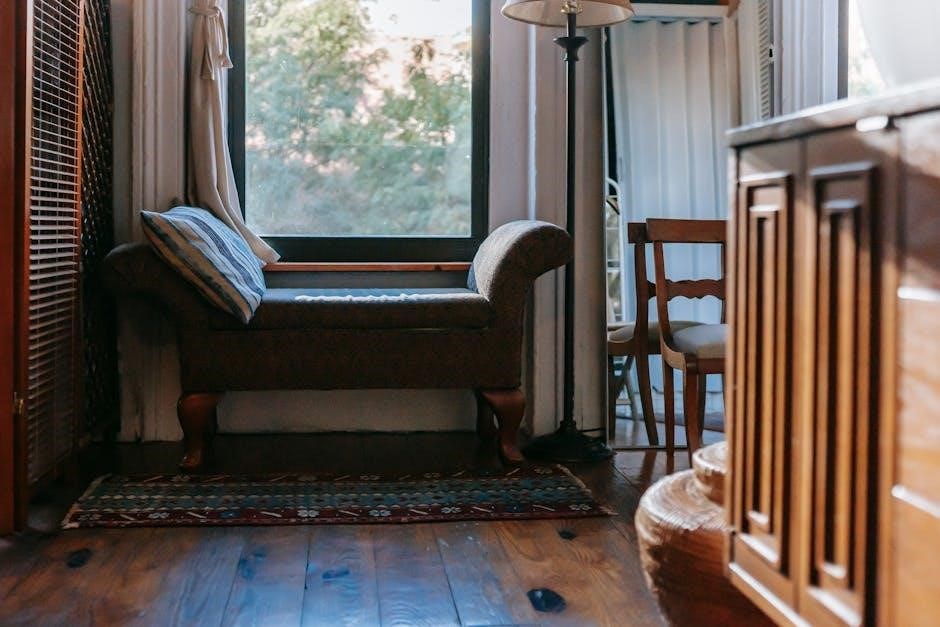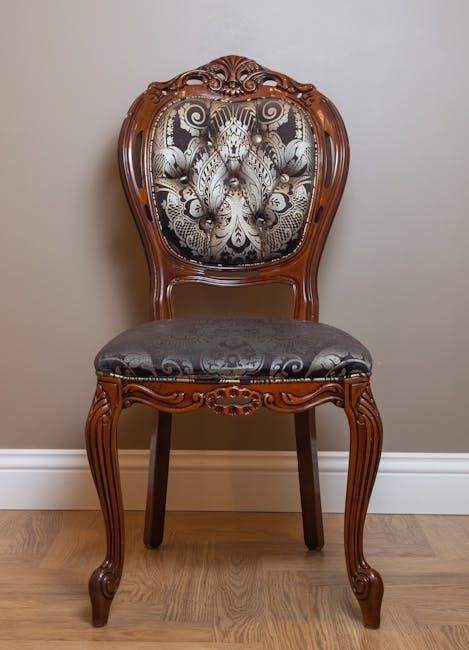To identify antique rocking chairs, examine the chair’s style, materials, and craftsmanship, using a guide or expert advice to determine its age and value, typically over 100 years old, on various online platforms․
Understanding the Basics of Antique Rocking Chairs
Understanding the basics of antique rocking chairs is essential for identification and valuation․
A comprehensive guide provides an overview of the history and evolution of rocking chairs,
including design styles, materials, and craftsmanship․
The construction and condition of the chair are critical factors in determining its age and value․
Online resources and expert advice can help individuals navigate the complex world of antique rocking chairs․
Additionally, examining the chair’s hardware, upholstery, and other components can provide valuable clues about its origins and authenticity․
By gaining a deeper understanding of the basics of antique rocking chairs, collectors and enthusiasts can make informed decisions when purchasing or selling these unique pieces of furniture․
The internet offers a wealth of information on the topic, including articles, forums, and online marketplaces where antique rocking chairs can be bought and sold․
Overall, understanding the basics of antique rocking chairs is a crucial step in the identification and valuation process․
It requires careful examination, research, and expertise to accurately determine the age, value, and authenticity of these antique pieces․

Characteristics of American Style Rocking Chairs
American style rocking chairs often feature wooden frames, curved legs, and padded seats, typically crafted in the 18th and 19th centuries, with unique designs and ornamentation, on various online platforms and stores․
Examining the Features of Hitchcock Chairs
Hitchcock chairs are a type of American style rocking chair, known for their unique features and craftsmanship․ They typically have a wooden frame, with curved legs and a padded seat, and are often decorated with intricate carvings and ornamentation․ The Hitchcock chair is named after the manufacturer, Lambert Hitchcock, who produced these chairs in the early 19th century․ To identify a Hitchcock chair, look for the characteristic curved legs and padded seat, as well as the distinctive ornamentation and carvings․ The chairs were often made with high-quality materials, such as solid wood and comfortable upholstery, and were designed to be both functional and aesthetically pleasing․ By examining the features of a Hitchcock chair, you can gain a better understanding of its history and value, and learn to identify these unique and beautiful pieces of furniture․ The Internet provides a wealth of information on Hitchcock chairs, including photos and descriptions of various models and styles․

Determining the Value of an Antique Rocking Chair
Experts use various methods to determine the value of antique rocking chairs, considering factors like age, condition, and rarity, to estimate their worth, typically ranging from 100 to 3500 dollars or more, online․
Factors Affecting the Value of Antique Rocking Chairs
Several key factors influence the value of antique rocking chairs, including rarity and desirability of style, with some styles being more sought after by collectors․ The condition of the chair is also crucial, with chairs in good condition being more valuable․ Additionally, the materials used to make the chair, such as wood or fabric, can affect its value․ The age of the chair is also an important factor, with older chairs generally being more valuable․ Other factors that can affect the value of an antique rocking chair include its provenance, or history of ownership, and any restoration or repair work that has been done․ By considering these factors, collectors and enthusiasts can determine the value of an antique rocking chair and make informed decisions about purchasing or selling․ Overall, the value of an antique rocking chair is determined by a combination of its rarity, condition, and historical significance․

Identifying Rare and Desirable Antique Rocking Chair Styles
Collectors seek rare styles, including Salem, Shaker, and Thonet Bentwood rockers, with unique features and historical significance, on various online platforms and marketplaces, every day, always․
Recognizing Salem, Shaker, and Thonet Bentwood Rockers
To recognize Salem, Shaker, and Thonet Bentwood rockers, examine the chair’s design, materials, and craftsmanship, considering the historical context and cultural influences that shaped their creation, on various online platforms and marketplaces․
These rare and desirable styles are characterized by unique features, such as the Salem rocker’s curved legs, the Shaker rocker’s simple and functional design, and the Thonet Bentwood rocker’s distinctive bentwood frame, which set them apart from other antique rocking chairs․
By studying the characteristics of these styles, collectors and enthusiasts can develop a deeper understanding and appreciation of the craftsmanship and history that went into creating these exceptional pieces of furniture, and make informed decisions when purchasing or selling them, every day, always, with great care and attention to detail, using a guide or expert advice․

and Final Thoughts on Antique Rocking Chair Identification
By following a guide or seeking expert advice, collectors and enthusiasts can navigate the complex world of antique rocking chair identification, making informed decisions when purchasing or selling these unique and valuable pieces of furniture, and appreciating their cultural and historical significance․
Ultimately, the process of identifying antique rocking chairs is a rewarding and educational experience, allowing individuals to develop a deeper understanding and appreciation of the craftsmanship, design, and history that went into creating these exceptional pieces, and to preserve their legacy for future generations, using various online platforms and resources, with great care and attention to detail, always․
